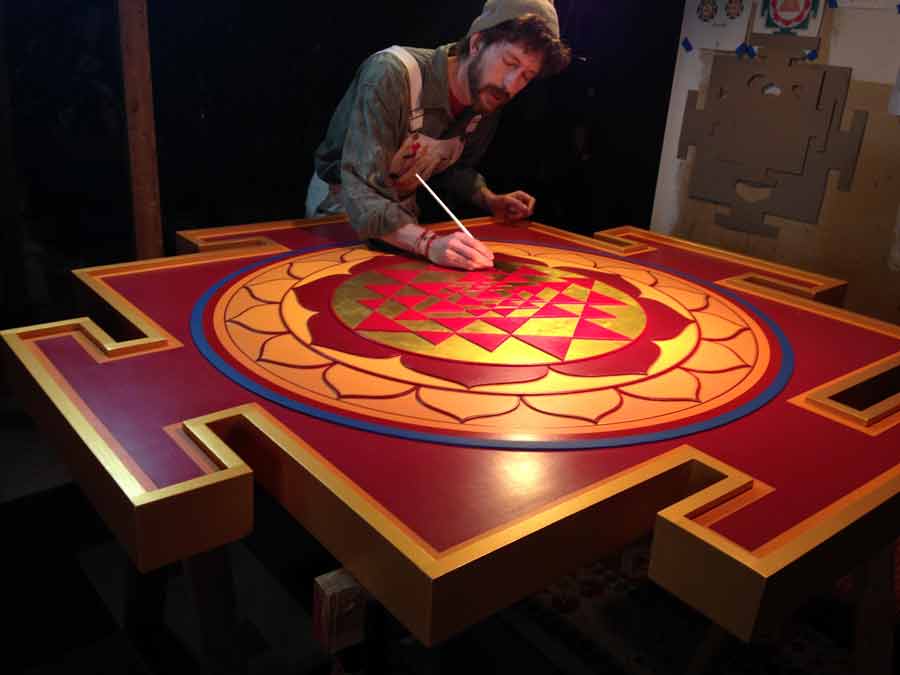
Ekabhumi Charles Ellik at work
Excerpted from "The Shakti Coloring Book"
Copyright © 2015 Ekabhumi Charles Ellik with permission of Sounds True
I found I could say things with color and shapes
that I couldn’t say any other way, things I had no words for.
Georgia O’Keeffe (1887–1986)
Now you will learn to create a simple yantra suitable for use with the Five Elements Meditation (Tattva Shuddhi). This meditation is a
purification practice and is a foundation for higher-level yogic endeavors. Purification here does not mean rejection; rather, it implies the release of
attachments so we may directly experience our inherent unity with all creation. Aspects of this Five Elements Meditation have been incorporated into the
yantra instructions. Utilizing the given steps, you can make an accurate image of any size using only a straight edge, a compass, and a drawing instrument.
Remember, this pretty picture itself will not do anything to you. It is an instrument that you may utilize to repattern your inner landscape. When engaged
mindfully and vigorously, the practice of creating a yantra has the benefits of harmonizing both sides of the brain, calming the nervous system, focusing
attention, building eye-hand coordination, and balancing the elements that comprise your physical and energetic body. Plus, it’s just plain satisfying to
make something lovely.
Overview of the Practice
All of us are manifestations of Shakti, but making a conscious choice to align with her creative power by making a yantra is a transformative experience.
When we do so, we recognize our inherent creativity and become a clearer channel through which this power may flow. Making a yantra can have a profound
effect on the creator, so take time to prepare carefully before making one for the first time. Dedicating your first yantra to a friend in need, a beloved
teacher, or to all beings is a wise way to begin.
Please do not skip any of the given steps, as they have been carefully arranged to give the most beneficial results.
While drawing, it is important to proceed in a meditative manner, rather than fixating on a certain deadline. The process is as important as the product.
We seek to craft an elegant artwork as an expression of our love of the process, rather than to match some external standard. That said, while it is okay
to finish the yantra over several days, it is best not to let it sit incomplete for too long. It is important to finish your yantra, even if the final
product is less than perfect. In fact, the opportunity to learn and grow from this practice depends upon a willingness to look soberly any “mistakes” or
lapses in awareness.
It is normal to experience some challenges your first time making sacred art. Any difficulties, frustrations, strong emotions, or even coincidences that
arise may be related to the karmas being rectified. If your experience becomes too intense, feel free to take a break and schedule a specific time to
resume.
It is not necessary to color the finished yantra, but if you intend to leave it as a line drawing, please use red ink and erase any gray pencil lines. If
you detect an error or make a “big mistake,” please skip ahead to step 20 before discarding the yantra. If you must leave the yantra incomplete for any
reason whatsoever, do not trash it. Please treat it respectfully as you send the elements back to their origins by recycling the paper. Burning it, placing
it in a stream, and giving it to the ocean are customary ways to return the elements to nature, if you haven’t used toxic pigments and you honor local
laws.
Tools and Materials:
• Sharp graphite pencil
• Loving awareness
• Eraser
• Playful curiosity
• Ruler with a clean, straight, undamaged edge
• Patience
• Compass for drawing circles
• Sense of humor
• A thick sheet hot-pressed (smooth) watercolor paper. Any size may be used, but beginners may find the size of a sheet of typewriter paper (8.5” x 11”) to
be easiest.
• A wooden board to use as a work surface. This is to prevent the needle of the compass from harming household furniture. The board should be slightly
larger than the sheet of paper you have selected.
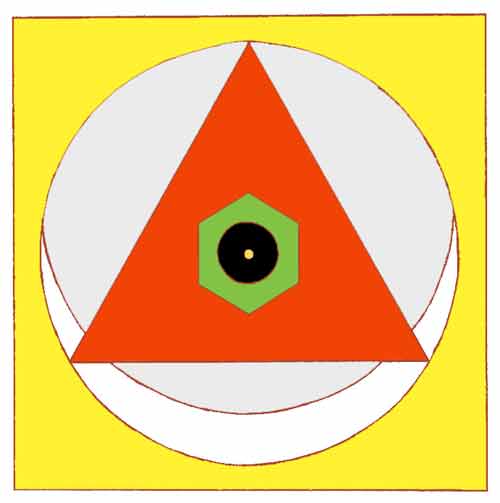
Five Elements Yantra
The Steps
1. Preparation and orientation
Clean yourself, tools, and work space. Choose an appropriate work setting free of disturbances and distractions. Select an auspicious time to begin,
perhaps at sunrise, a new-moon day, a full-moon day, and/or a holy day. Determine which direction to face (usually east or north) while working. Or simply
imagine facing the rising sun and feeling the brightness and expansion of energy. Organize your tools and materials.
2. Purification.
Choose a purification technique, such as burning incense, sprinkling rosewater, or ringing a bell. Purify your body, tools, materials, and workspace.
3. Divinization.
Divinize the body (nyāsa). Place the heel of the right hand on the forehead so that the wrist is over the third eye and the middle finger is on or
near the top of the head. Chant Oṁ three times, drawing the energy of this sacred mantra into the hand. Then place the right hand on the lower
belly and chant Oṁ, imagining a ruby red light in the center of the pelvic bowl. Move the right hand over the heart, chant Oṁ, and
imagine a brilliant cobalt blue light in the heart center. Then place the hand on top of the head, chant Oṁ, and imagine a radiant white light in
the center of the skull. Pause and recognize that you have invoked your most expansive Self. Visualize the finished yantra as a living presence, brilliant
and pulsing with life.
4. Declare your resolve.
Once you are ready to begin, clarify your motive and intention for making this yantra. Set your resolve (sankalpa) by speaking it out loud. Here
is an example: “I resolve to make a yantra of the five elements for the benefit of all beings.” Pause for a moment and consider the blank drawing surface,
which represents the formless void where all creation will appear.
5. Establish the orientation.
Write Ganesha’s mantra, Oṁ Gaṁ Ganapatye Namaha, in small letters at the top left side of your drawing surface. This will help orient the
work. It is also blesses the project.
Usually, the top of a deity yantra is mystically understood as the eastern direction, direction of the rising sun and expanding energy. In these
instructions, we will use directions like a map to help describe where to make marks on the yantra. The top of the drawing is east. In the rest of these
instructions, the word east will be abbreviated to the letter E. South is S, west is W, and north is N. It may be helpful to actually write down the compass directions lightly near the edges of your paper.
At the top of your paper, next to Ganesha’s mantra, write Oṁ and the mantras of the five great elements (mahābhūtas): Oṁ, Lām, Vām, Rām, Yām, Hām. We will chant each of these mantras in a specific sequence as we work. You may chant silently or in a quiet, even
voice. Begin chanting Oṁ. If the chanting falters at any time during this project, simply pause and restart the chanting.
6. Find the center.
By choosing to place a mark in a specific location, you have moved the energy of your intention into manifestation, setting the wheel of karma in motion.
With this choice, creation begins. It is only out of convenience that you will measure the page, as the center, or bindu, could be drawn anywhere
and is everywhere all at once.
Find the exact center of the page by gently drawing two diagonal lines from corner to corner. These lines will be erased later, so leave them faint. This
center point will be the location of the bindu, which traditionally is the last piece of a yantra to be drawn (see step 20). This is an excellent
time to take a few deep breaths and become aware of your physical center, your spine, and especially your heart center.
7. Draw a small circle.
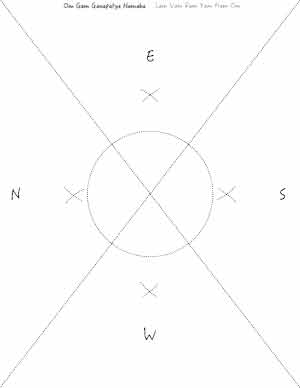
Figure 1
It is the force of desire that causes us to expand outward from the center. Because this primordial desire moves in all directions, it is drawn as a circle
and represents the radius of desire. In general, we start at the top of the figure and work in a clockwise direction when creating yantras. The east is the
direction of the rising sun, so the clockwise motion symbolizes expansion of awareness.
The exact size of the circle we draw is unimportant, but one with a radius of approximately two inches (5 cm) will be helpful in the next steps. Place the
needle of the compass at the center point and gently draw a small circle in the clockwise direction. It will be erased later, so don’t press too hard. This
compass setting (the distance between the needle and lead) will be used in the next step, so be careful to keep it.
8. Measure for horizontal and vertical lines.
Move the compass to the top right side of the drawing, the southeast (SE) corner, and place the needle where the circle crosses the SE diagonal line.
Swing the lead to make a new mark at the top (E) of the drawing, outside of the small circle and approximately halfway between the top two diagonal lines.
Next, move the needle to where the circle crosses the NE diagonal line, and swing the lead to cross the new mark, making an X shape exactly halfway between
the two diagonal lines at the top of the page. Continue this process, making an X between the two diagonal lines on the right (S) side of the drawing. Move
the needle of the compass to the other diagonal lines and repeat. When you are done, there will be four small, X-shaped marks outside the circle, each
halfway between the diagonal lines (figure 1).
9. Make the brahma line and horizon line.
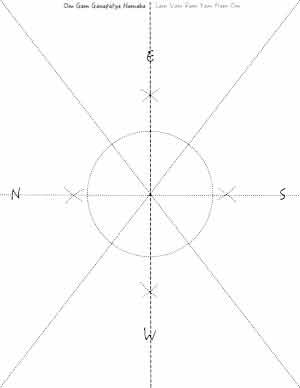
Figure 2
So far, you have been making only preparatory marks for the sake of orientation. They will be erased later. In this step, you will be your first important
mark, symbolizing the first creative act. This is the brahma line, dividing the drawing surface in half vertically, from east to west. You will
keep this line until the drawing is complete. It is said to have the quality of fire, which rises. Straight lines are said to have the quality of light
rays, piercing the gloom of ignorance. Here, duality comes into being as we divide the formless void into “this” and “that.”
Pause for a moment, take a breath, and remember your motive for making this yantra. Gently draw a vertical line from the top of the drawing surface to the
bottom, passing exactly through the top X and the bottom X. This line will be erased later, so draw gently.
Next, gently draw the horizon line. It connects the two X marks on either side, running through the middle of the circle and bisecting the brahma
line (figure 2). This line is said to have the quality of water, which flows and spreads. The qualities of fire and water are naturally opposed, but it is
their interaction that makes everything else possible.
10. Erase the original diagonal lines, X marks, and small circle.
These preparatory marks may be confusing later. Only the vertical brahmā line and the horizon line are left intact.
11. Draw a large circle.
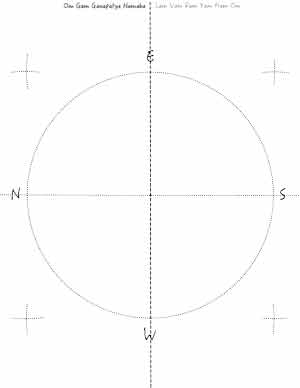
Figure 3
The next circle you draw will determine the overall size of this yantra. This circle represents the universe and the quality of fullness. There is some
freedom to choose the size, but leave a healthy margin, at least two fingers wide, between the circle and the outside edge of the drawing surface to allow
for measurements and corrections. If you are using an 8.5-by-11-inch sheet of paper, a circle with a radius of approximately 3.5 inches (9 cm) from the
center is convenient. This circle will be erased later, so be certain the lines are faint.
Place the needle of the compass again at the center, then gently draw a large circle. Keep this compass setting, as you will use it later.
12. Draw a square.
You will now draw a large square inside the circle. The square represents the earth element (prithvī), symbolically grounding the energy of this
yantra in our physical reality. Begin silently chanting the earth-element mantra, Lām, continuously.
First, you will use the compass to measure for true forty-five-degree diagonal guidelines. Using the same compass setting as the one you used for step 11,
move the needle toward the top (E), where the vertical brahma line intersects the circle. To the right, gently make a small mark with the
compass, approximately halfway between the vertical brahmā line and horizon line, in the NE area outside of the circle. Repeat on the left side of
the brahmā line (SE). Move the needle of the compass to each of the other three locations (S, W, and N), and continue making the small marks where
the vertical and horizontal lines cross the circle. There will be four small X-shaped marks in the corners when you are done (figure 3).
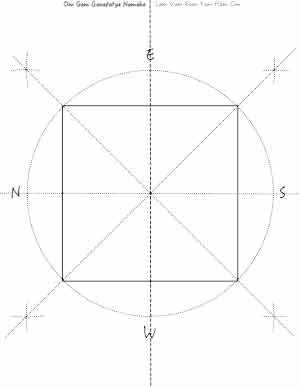
Figure 4
Next, draw in the forty-five-degree diagonal guidelines. Use the ruler to connect two of the X marks, making sure your line passes exactly through the
center point. Connect the other two. Diagonal lines are said to have the quality of wind, which is always in motion.
Now you can draw the square inside the circle by connecting the points where the diagonal lines cross the circle. (See figure 4.)
The earth element is associated with stability, weight, cohesion, and the sense of smell. This is an excellent time to pause and become aware of
your physical body, especially from the knees down to the feet. Be aware of the weight of your body on the ground, of your alignment with gravity.
13. Erase the diagonal lines.
Erase the diagonals, the X marks used to create them, and any other unnecessary lines. Only the square shape, the vertical and horizontal lines, and the
large circle remain.
14. Draw the main circle.
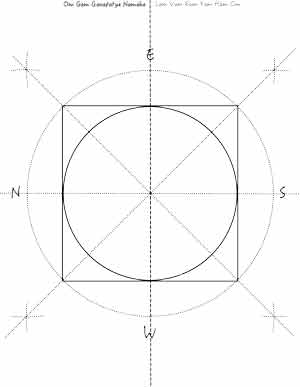
Figure 5
This circle will help form the shape of a crescent, like a new moon. The crescent represents the water element apas), creativity, taste,
nourishment, and flow. Begin silently chanting the water-element mantra, Vām, continuously.
The main circle is drawn inside the square. Place the compass needle in the center point and the lead on the top line of the square, where it intersects
the brahmā line. Moving the compass lead clockwise, draw the circle; be certain that the outside edge of the main circle touches inner sides of
the main square. (See figure 5.) Save this setting on your compass, as you will use it in the next two steps.
The water element is associated with the pelvis and, consequently, the reproductive organs. Pause for a moment and consider your revered ancestors who
passed down spiritual teachings across the vast sea of time. Invoke a sense of awe and wonder, of being nourished by this knowledge. Cultivate a sense of
gratitude, which is an enlightened virtue. Gratitude is not simply an experience that happens to us; it is also a disposition we choose.
15. Draw inner arc of the crescent.
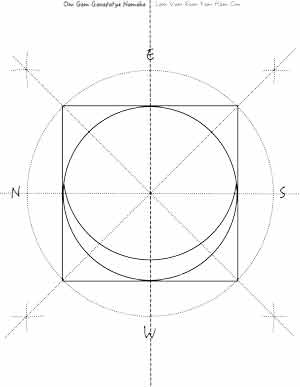
Figure 6
Place the needle of the compass on the brahmā line, a short distance above the center point. How far the needle is moved up from the center point
will determine the thickness of the crescent moon shape. A distance of approximately one quarter the radius of the main circle is suggested. If you are
making your yantra on an 8.5-by-11-inch page, this is distance is about a half inch (1.5 cm). Using the same compass setting you used to make the main
circle, swing the lead of the compass from side to side inside the lower half of the main circle, creating the inner arc of a crescent shape. (See figure
6.) Save this compass setting, as you will use it in the next step.
16. Draw the upward-pointing triangle.
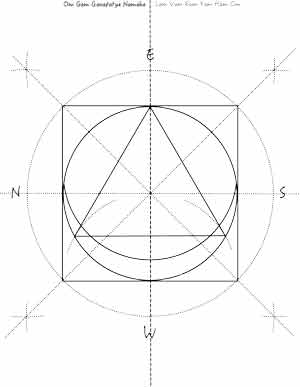
Figure 7
Triangles are associated with the fire element (agni) and the process of transformation. Upward-pointing triangles are used in ritual to transform
our experience of duality to unity. Begin silently chanting the fire-element mantra, Rām, continuously. The three tips of this triangle
will touch the inside of the main circle and overlap part of the crescent moon shape.
Mark where the base of the triangle will touch the main circle. Place the needle of the compass at the lower point where the brahmā line crosses
the main circle, which is also the bottom arc of the crescent. Using the same compass setting as was used to make the main circle, swing the compass to
make two faint marks on either side, crossing the circle (figure 7). These two marks will be used to make the horizontal line that forms the base of the
triangle.
Use a straight edge to draw a horizontal line between the places where the two marks and the circle intersect. Then draw two diagonal lines connecting the
lower two corners of the triangle to the upper tip, where the brahma line intersects the main circle.
The fire element is associated with brightness, sight, sharpness, perception, digestion, radiation, and verticality. It is also associated with the region
between the heart and the navel. More esoterically, this upward-pointing triangle represents the power of dissolution, of moving from diversity (wide base
of the triangle) upward to unity (tip of the triangle). It is said that we need to cultivate our inner fire to “digest” memories and experiences,
transforming them from obsessions and attachments to liberated wisdom. If our physical digestion is upset, it is unlikely we will be able to process
challenging experiences, either.
17. Draw the hexagon.
We are now ready to draw in the hexagon, which symbolizes to the wind element (vāyu). So begin silently chanting the wind element mantra, Yām, continuously. This shape is more complex than the others and will require several substeps of its own. We will draw a circle, and
then create a six-pointed star from two overlapping triangles (pointing to either side). The hexagon shape we will keep is naturally formed inside this
six-pointed star. Please draw lightly, so the unneeded preliminary shapes and lines can be erased after the hexagon is formed.
17a. Lightly draw a small circle.
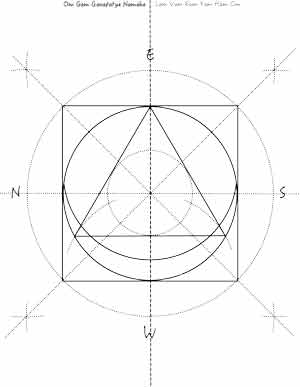
Figure 8
This circle will be inside of the large triangle drawn in step 16 and touch each of the three sides. Place the needle at the center point, touch the lead
to the diagonal right side (SE) of the triangle, and draw clockwise (figure 8). The width of the compass will be used in the next step, so be careful not
to change it. If the circle does not touch all three sides of the triangle, do not move the circle. It isn’t the circle that’s off; it’s the triangle. Go
back and adjust the triangle until it is symmetrical, then redraw the circle within it. Making sure the triangle is symmetrical and the circle touches all
three sides ensures that your yantra has been accurately drawn.
17b. Make two triangles.
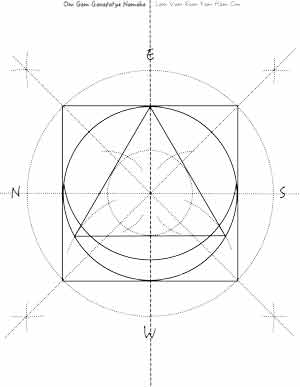
Figure 9
Now we are going to make two triangles—one pointing left and one pointing right—inside the small circle. This will form a six-pointed star. Place the
needle of the compass on the right side of the small circle, where it intersects the main horizontal line. Swing the lead of the compass to make two short
marks on the circle, above and below. (See figure 9.) Repeat on the left side of the small circle, so that there are four short marks.
17c. Draw the six-pointed star.
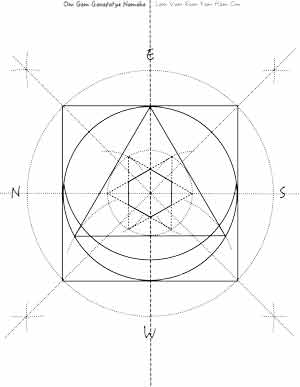
Figure 10
Draw a vertical line connecting the upper and lower mark on the right side (S) of the circle. Repeat on the left side (N). You will now have two parallel
vertical lines inside the small circle, one on either side. Now draw a diagonal line downward from the top end of the vertical line on the left side (NE)
to the location where the horizon line crosses the small circle on the right (S). (See figure 10.) Now connect the bottom end of the line on the left (NW)
diagonally upward to the point of the triangle on the right (S). Repeat on the opposite side to form two overlapping triangles, one pointing left, one
pointing right.
17d. Erase around the hexagon.
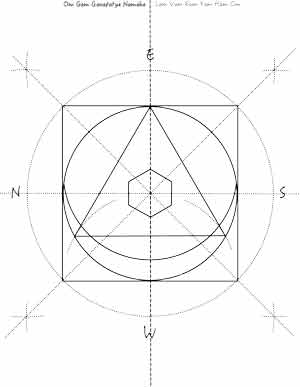
Figure 11
The six-sided shape created within the two interlocked triangles is the hexagon. Simply erase the unneeded triangular points of the star and the small
circle around the hexagon. Allow all other lines to remain in case the figure needs to be adjusted or redrawn. (See figure 11.)
The wind element represents kinetic energy and is associated with the subtle breath (prāna) as well as with motion, gaseousness, contraction,
expansion, and the sense of touch. This element is associated with the region of the body from the heart to the eyebrows. The hexagon relates to the mind,
so it is fitting that any lapses in awareness made earlier in the drawing process become apparent here as a distorted, uneven, or asymmetrically shaped
hexagon. If it is distorted, go back and determine where the error occurred. Rectify the issue and methodically work your way forward to this step. If
you’ve made a “big mistake,” please skip ahead to step 21 before adjusting the drawing.
Once the hexagon is complete and symmetrical, pause for a moment and meditate on the breath. A simple meditation technique is to simply count while
inhaling and the exhaling. Slowly breathe in for a count of six, and then breathe out for a count of six. Do this six times in honor of the wind element.
18. Draw a small circle inside the hexagon.
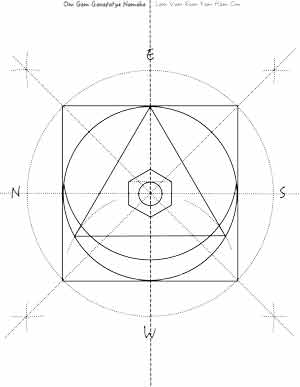
Figure 12
You are now ready to draw a small circle within the hexagon to represent the space element (ākāsha). This circle should be visualized as a
three-dimensional sphere, not just a two-dimensional circle. Begin silently chanting the mantra Hām continuously.
This circle may be of any size, so long as it is smaller than the hexagon. I suggest making it about half the size of the hexagon. If you would like a more
precise measure, draw a horizontal line inside the hexagon from the NE corner across to the SE corner, skipping the top corner (E). Place the needle of the
compass at the center point, and touch the lead to where this new horizontal line crosses the brahmā line. Draw a small circle in the clock-wise
direction. (See figure 12.)
The space element, or ether, is the most subtle of the five great elements; it is all pervading and motionless. This element is associated with the sense
of hearing and the area of the head from the eyebrows upward. This element is associated with that part of our spirit that simply is. Pause for a
moment and do nothing. Simply witness yourself in this place and time. Be aware of the shape of your body in space, the weight of your body on your seat,
the spontaneous movement of your breath, the beating of your heart.
19. Compare your drawing to the diagram of the finished yantra.
Refer back to image of the Five Elements Yantra at the beginning of the chapter. Make any final adjustments so that your drawing matches the yantra as
accurately as possible. Darken in any lines as needed and thoroughly erase all unnecessary lines.
20. Draw the bindu.
Begin silently chanting the mantra of ultimate unity, Oṁ. The ultimate is represented with the most fundamental mark an artist can make: a dot. To
the practitioner, it is not a physical object. It represents the instant of manifestation, the first pulse of desire, and the final union of opposites.
This is the last and most important step in the drawing of a yantra. This action is equivalent to “opening the eyes” of the deity in a figurative image.
Pause and recollect your motive for this undertaking. There is no need to use the compass for this step. Simply draw a small circle at the center point.
21. Add colors.
Work systematically from the outer edge toward the center, one color at a time. Work clockwise all the way around until each area of color is filled. Then
move inward to the next color. As you work, feel the effect of each color; let it saturate your awareness. Recollect the attributes of each element.
The suggested colors for a five elements yantra are as follows:
Outer square (earth):
a rich golden yellow. Mantra: Lām.
Inside the crescent shape (water):
pure white. Be careful not to paint over the tips of the triangle. Mantra: Vām.
Inside the rest of the large circle:
silver or a misty white-blue. Mantra: Vām.
Triangle (fire):
scarlet red. Mantra: Rām.
Hexagon (wind):
gray-green or “smoky.” Add a tiny amount of white and an even less red to basic green for this color. Mantra: Yām.
Small circle (space):
This element is completely invisible, so it is variously visualized as dark, crystal, or as a scintillating mass of colored lights. Plain black is
suggested. Mantra: Hām.
Center dot:
iridescent gold or pure white. Mantra: Oṁ.
22. Self-reflection.
Pause and reflect on the process of making this yantra. Were any of the shapes particularly difficult to draw or paint? The moment when an “error” is made
is a chance to reflect on the impulse, thought, or memory caused the lapse of awareness. We must follow the sequence of thoughts or actions back to their
origin and discover the root cause. It may be a personal issue that needs to be addressed or a karmic attachment needing to be rectified.
When we create a ritual space in which to work, all actions have increased significance. Though any error could simply be a coincidence, it remains an
opportunity to witness our reactive impulses as we cope with difficulty, disappointment, and change. An artist who simply copies this yantra perfectly
without using the process to self-reflect has missed the entire purpose of this meditation, which is to come into greater awareness of our karmic
relationship with the elements. In this sense, errors are to be treasured as glimpses of our own true nature and opportunities for personal growth.
In the case of this yantra, we may also consider the element that was being invoked when the error occurred. Look for any correlation between the element
and your own life. Even if there is nothing to “fix,” this is an opportunity to contemplate deeply. For example, if you made a mistake while drawing or
coloring the crescent moon, review the qualities of the water element and consider if there is any correlation between the water element’s associations and
aspects your daily life. Here are the elemental associations again:
Earth/square/yellow:
stability, mass, solidity, substance, sense of smell, the root chakra and/or lower legs.
Water/crescent/silver and white:
emotions, nourishment (too much or too little), sense of taste, elimination, birth, the quality of flow, and pelvic region in the body.
Fire/triangle/red:
transformation, digestion, heat, charisma, light, sense of sight, the region of the body from belly to heart.
Wind/hexagon/green:
motion, chaos, change, instability, mind, sense of touch, the region of the body from heart to eyebrows.
Space/sphere/black:
awareness, consciousness, witnessing, “enough room,” sense of hearing, and the area of the head from eyebrows upward.
23. Completion.
Pick a special moment to paint in the center dot. Seal the practice with a final mantra, such as Oṁ Shāntiḥ, Shāntiḥ, Shāntiḥ (pronounced, Ohm, Shahntee, Shahntee Shahntee-hee). Then relax and enjoy the finished artwork. Release any evaluation or critique or story about the process.
This moment of easeful contemplation is a traditional aspect of bringing the practice to close; experience the satiation of desire (kāma) and
release all attachment (moksha). Abide.
That is Full, this is Full, from Fullness comes Fullness;
taking Fullness from Fullness, only Fullness remains.
Brhadāranyaka Upanishad